
HNUE JOURNAL OF SCIENCE
Natural Science, 2024, Volume 69, Issue 1, pp. 3-13
This paper is available online at http://stdb.hnue.edu.vn
DOI: 10.18173/2354-1059.2024-0001
A VARIABLE METRIC INERTIAL FORWARD-REFLECTED-BACKWARD
METHOD FOR SOLVING MONOTONE INCLUSIONS
Nguyen Van Dung
Department of Mathematical Analysis, University of Transport and Communications,
Hanoi city, Vietnam
Corresponding author: Nguyen Van Dung, e-mail: dungnv@utc.edu.vn
Received February 12, 2024. Revised March 15, 2024. Accepted March 28, 2024.
Abstract. We propose a new method for finding a zero point of a sum
involving a Lipschitzian monotone operator and a maximally monotone operator,
both acting on a real Hilbert space. The proposed method aims to extend
forward-reflected-backward method by using inertial effect and variable metric.
The weak convergence of the proposed method is proved under standard
conditions.
Keywords: monotone inclusion, forward-reflected-backward method, variable
metric, inertial effect.
1. Introduction
Many important issues in operator theory, fixed point theorems, equilibrium
problems, variational inequalities, convex optimization, image processing, or machine
learning, reduce to the problem of solving monotone inclusions involving Lipschitzian
operators (see [1-6] and the references therein). In this work, we consider the monotone
inclusions of finding a zero point of sum of a maximal monotone operator Aand a
monotone, L-Lipschitzian operator B, acting on a real Hilbert space H, i.e.,
Find x∈ H such that 0∈(A+B)x. (1.1)
Throughout this paper, we assume that a solution xexists. For solving problem (1.1),
several methods have been proposed. The first one is the forward-backward-forward
method proposed by Tseng [7]:
γ∈]0,+∞[,(yk=JγA(xk−γBxk)
xk+1 =yk−γByk+γBxk.
3

Nguyen VD
A limitation of this method is that at each iteration step, one has to compute twice the
values of operator B. This issue was recently resolved in [6], the forward reflected
backward splitting method was proposed, namely,
γ∈]0,+∞[, xk+1 =JγA(xk−2γBxk+γBxk−1).(1.2)
The convergence of (1.2) is derived under condition that γ < 1
2L. In [5],
for solving problem (1.1), an alternative method was proposed, namely the
reflected-forward-backward method. We notice here that the methods in [5-7] are limited
to the fixed metric. While the variable metric methods have obtained a lot of attention
in the literature (see [8-12] and the references therein). Variable metric methods improve
the convergence profiles.
In this paper, we consider a new splitting method for solving problem (1.1). The
proposed method extends the forward-reflected-backward in [6] by using variable metric
and inertial effect. In [13], Polyak introduced the so-called heavy ball method in order
to speed up the classical gradient method. This idea was employed and refined by some
authors. In [14], Alvarez and Attouch employed the heavy ball method and proposed the
inertial proximal point algorithm. We emphasize that use of inertial effects helps increase
the convergence rate of the algorithm [15, 16].
2. Preliminaries
2.1. Notations
We recall some notation and background from convex analysis and monotone
operator theory (see [1] for detail).
The scalar products and the associated norms of a Hilbert space Hare denoted
respectively by ⟨· | ·⟩ and ∥ · ∥. The symbols ⇀and →denote respectively weak and
strong convergence. We denote by B(H)the space of bounded linear operators from H
in to itself and S(H) = {K∈ B(H)|K=K⋆}, where K⋆denotes the adjoint of K. The
Loewner partial ordering on S(H)is defined as:
(∀U∈ S(H))(∀V∈ S(H)) U≽V⇐⇒ (∀x∈ H)⟨Ux |x⟩ ≥ ⟨V x |x⟩.
Let θ≥0, we set
Pθ(H) = {U∈ S(H)|U≽θId},
for U∈ Pθ(H), we define a semi-scalar product and a semi-norm (a scalar product and a
norm if θ > 0) by:
(∀(x, y)∈ H2)⟨x|y⟩U=⟨Ux |y⟩and ∥x∥U=p⟨Ux |x⟩.
Let A:H → 2Hbe a set-valued operator. The domain of Ais denoted by dom(A)
which is a set of all x∈ H such that Ax =∅. The range of Ais ran(A) =
4

A variable metric inertial forward-reflected-backward method for solving monotone inclusions
u∈ H | (∃x∈ H)u∈Ax. The graph of Ais gra(A) = (x, u)∈ H × H | u∈Ax.
The inverse of Ais A−1:u7→ x|u∈Ax. The zero set of Ais zer(A) = A−10.
We denote as ℓ1(N)the space of absolute summable sequences.
Definition 2.1. We say that an operator A:H → 2His
(i) monotone if
∀(x, u)∈gra(A)∀(y, v)∈gra(A)⟨x−y|u−v⟩ ≥ 0.
(ii) maximally monotone if it is monotone and there exists no monotone operator
B:H → 2Hsuch that gra(B)properly contains gra(A), i.e., there is no monotone
operator that properly contains it.
Definition 2.2. A mapping T:H → H is said to be
(i) L-Lipschitz continuous (L∈[0,+∞[) if
∥T x −T y∥ ≤ L∥x−y∥ ∀x, y ∈ H.
(ii) c-cocoercive (c∈[0,+∞[) if
⟨x−y|T x −T y⟩ ≥ c∥T x −T y∥2∀x, y ∈ H.
Definition 2.3. For A:H → 2H, the resolvent of operator Ais
JA= (Id +A)−1,
where Id denotes the identity operator on H.
Note that, when Ais maximally monotone, JAis an everywhere single-valued
operator [1].
2.2. Technical results
The following properties can be found in [8, 9]:
Lemma 2.1. [8, Lemma 2.1] Let θ∈]0,+∞[,µ∈]0,+∞[,and let A, B ∈ S(H)such
that µId ≽A≽B≽θId, then
(i) θ−1Id ≽B−1≽A−1≽µ−1Id.
(ii) (∀x∈ H)⟨A−1x|x⟩ ≥ ∥A∥−1∥x∥2.
(iii) ∥A−1∥ ≤ θ−1.
5

Nguyen VD
Lemma 2.2. [8, Lemma 2.3] Let θ∈]0,+∞[, let (ηk)k∈N∈ℓ1(N)and let (Wk)k∈N
be a sequence in Pθ(H)such that µ= supk∈N∥Wk∥<+∞. Assume that one of the
following holds:
(i) (∀k∈N) (1 + ηk)Wk≽Wk+1.
(ii) (∀k∈N) (1 + ηk)Wk+1 ≽Wk.
Then there exists W∈ Pθ(H)such that Wk→Wpointwise.
Lemma 2.3. [9, Lemma 3.7] Let A:H → 2Hbe a maximally monotone, θ∈]0,+∞[,
U∈ Pθ(H)and Gbe the real Hilbert space obtained by endowing Hwith the scalar
product (x, y)7→ ⟨x|y⟩U−1=⟨x|U−1y⟩. The following properties hold:
(i) UA :G → 2Gis maximally monotone.
(ii) JUA :G → 2Gis 1−cocoercive.
We also have the following results which are necessary to prove the convergence of
the algorithm:
Lemma 2.4. Assume (zk)k∈N,(αk)k∈N,(tk)k∈Nare nonnegative sequences such that
(αk)k∈Nis summable and
(∀k∈N)zk+1 ≤(1 + αk)zk−tk.
then (zk)k∈Nconverges and (tk)k∈Nis summable.
Lemma 2.5. Let (αk)k∈N,(θk)k∈N,(λk)k∈Nbe sequences in R. Assume that (λk)k∈Nis
absolutely summable sequence and there exists t > 0such that αk≥(1 + t)|θk|,∀k∈N.
Then, there exist a t0>0and k0∈Nsuch that ∀k≥k0, we have
αk
1 + λk
+θk≥αk+θk
1 + λk(1 + 1
t0).(2.1)
Proof. (2.1) is equivalent to
1 + λk(1 + 1
t0
)(αk+ (1 + λk)θk)≥(1 + λk)(αk+θk)
⇔λk
t0
αk+λk(1 + λk)(1 + 1
t0
)θk≥0
⇔αk+ (1 + λk)(1 + t0)θk≥0.
There exists a k0∈Nsuch that ∀k≥k0:|λk| ≤ t
2, then for t0≤t
t+2 , we have
|(1 + λk)(1 + t0)| ≤ (1 + t
2)(1 + t
t+ 2) = t+ 1.
Hence, we obtain the desired result from the condition that αk≥(1 + t)|θk|.
6

A variable metric inertial forward-reflected-backward method for solving monotone inclusions
3. Proposed method and convergences
3.1. Proposed method and related works
We develop the following variable metric framework for solving problem (1.1). Let
γ > 0,α≥0,(ηk)k∈Nbe a non-negative sequence in ℓ1(N)and (Uk)k∈Nbe a sequence in
Pθ(H) (θ > 0). Assume that
µ= sup
k∈N∥Uk∥<+∞and (∀k∈N) (1 + ηk)Uk+1 ≽Uk≽Uk+1.(3.1)
Let x−1, x0∈ H, we set (∀k∈N)
xk+1 =JγUkA(1 + α)xk−αxk−1−γ(2UkBxk−UkBxk−1).(3.2)
Remark 3.1. (i) The condition (3.1) was introduced in [8] and utilized in [9, 11, 12].
We also note that condition is satisfied in particular when Uk≡U∈ Pθ(H)and
ηk= 0 (∀k∈N). In case variable metric is not constant, we can choose Uk+1 =
Uk
1+ηk.
(ii) In the case when (∀k∈N)Uk= Id, α = 0, then (3.2) becomes the
forward-reflected-backward method proposed in [6].
Remark 3.2. Variable metric algorithms have a long history. Variable metric methods in
optimization were introduced in [10, 17] to improve the convergence profiles. The idea
was then extended to the variable metric proximal point algorithm to find a zero point of
a maximal monotone operator; see [8, 18, 19] for instances. For the problem of finding
a zero point of the sum of a maximally monotone operator and a Lipschitzian monotone
operator, the variable metric methods were developed in [11, 12].
3.2. Weak convergence
To prove the convergence of Algorithm 3.1., we need the following lemma.
Lemma 3.1. Let (xk)k∈Nbe a sequence generated from Algorithm 3.1., and x∈
zer(A+B), then we have
∥xk−x∥2
U−1
k
+ (γµL + 2α)∥xk−xk−1∥2
U−1
k−α∥xk−1−x∥2
U−1
k
+ 2γ⟨Bxk−1−Bxk|xk−x⟩
≥1
1 + ηk∥xk+1 −x∥2
U−1
k+1
+ (γµL + 2α)∥xk+1 −xk∥2
U−1
k+1 −α∥xk−x∥2
U−1
k+1
+ 2γ⟨Bxk−Bxk+1 |xk+1 −x⟩+ (1 −3α−2γµL)∥xk+1 −xk∥2
U−1
k
.(3.3)
Proof. From (3.2), we get
(1 + α)xk−αxk−1−γ(2UkBxk−UkBxk−1)−xk+1 ∈γUkAxk+1,
7


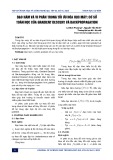
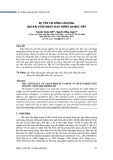
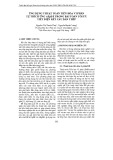
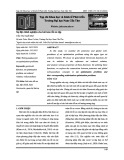
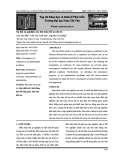

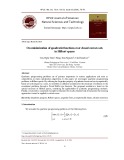
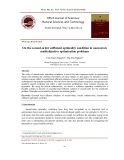















![Quyển ghi Xác suất và Thống kê [chuẩn nhất]](https://cdn.tailieu.vn/images/document/thumbnail/2025/20251030/anh26012006/135x160/68811762164229.jpg)
